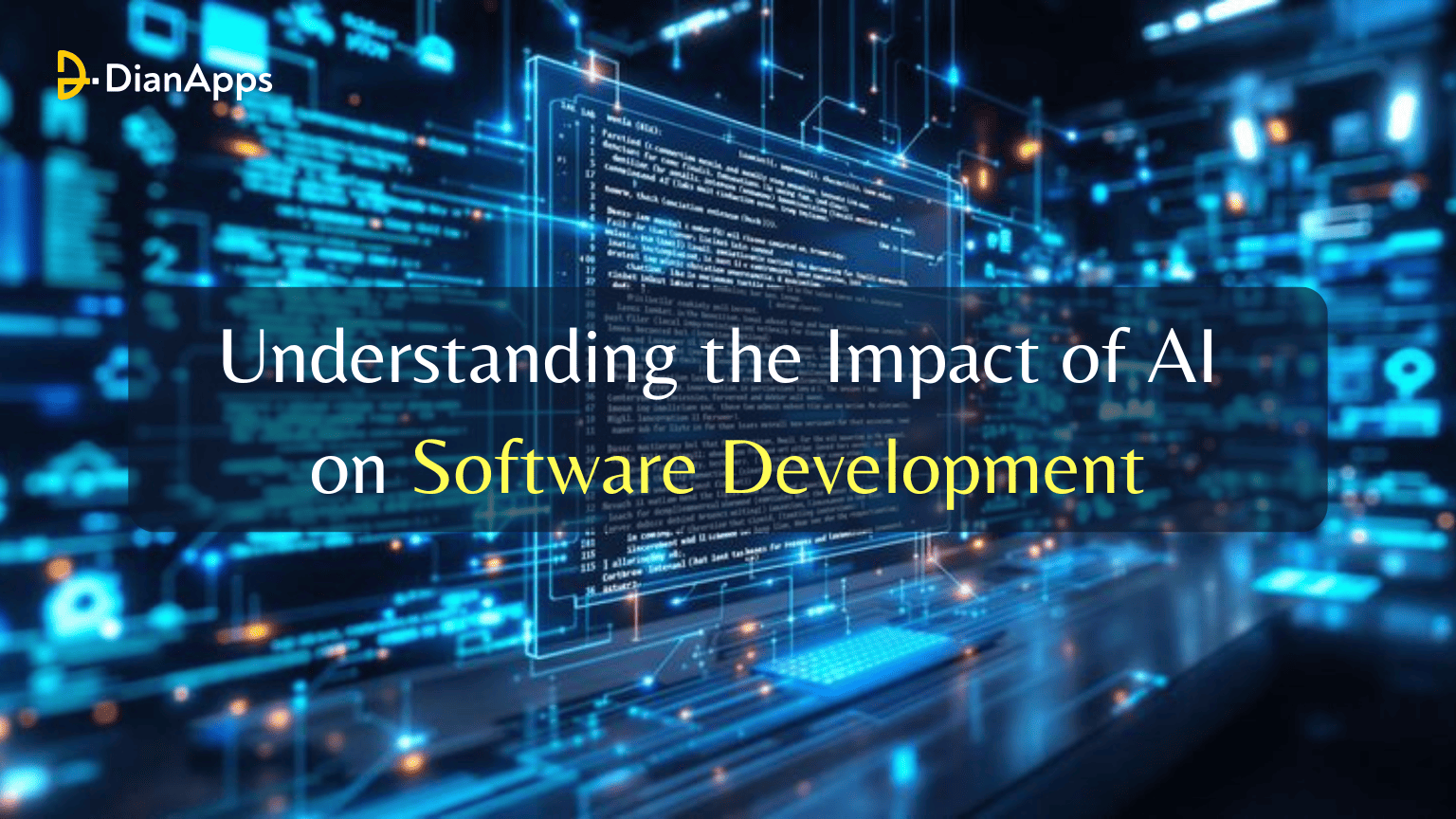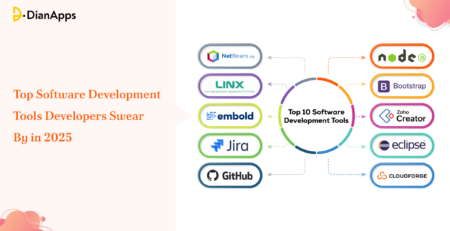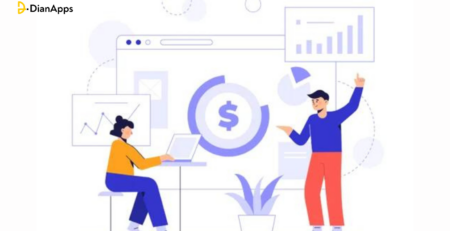Understanding the Impact of AI on Software Development
Artificial intelligence is capable of revolutionizing software development practices.
This sector is steadily shifting towards more advanced practices as most businesses, whether startups or enterprises, are looking for an AI-driven strategy. A Precedence Research study shows that the global artificial intelligence market is estimated to be around USD 757.58 billion in 2025 and is expected to reach USD 3,680.47 billion by 2034. Growth in the artificial intelligence market is accelerating at a CAGR of 19.20%.
The research report highlights the importance of adopting AI technology into the software development industry. From UI/UX design to the deployment phase, AI for the software development industry has huge potential.
So, let’s begin reading this blog to explore the various ways AI is enhancing efficiency and productivity in software development, along with the challenges of AI integration. A custom software development company is acquiring significant benefits from AI technologies, enabling it to deliver products more quickly and efficiently.
Impact of AI on Software Development
AI has become a popular tool and technique that enhances creativity, efficiency, and the overall development process. Other than these factors, it automates various routine tasks such as identifying bugs and errors, improving code quality, and analyzing vast amounts of data.
However, it is important to leverage AI technologies in the software development process to simplify overall workflows and reduce high development time. Here are some points that show in which areas AI plays an important role:
Prototyping
Prototyping is the initial stage of software development, where ideas are on their way to turning into reality. This process is where developers test whether it is possible to turn concerts into working models. The integration of AI has significantly streamlined this phase. AI has ensured to speed up the prototyping process, reducing errors. Rapid prototyping tools allow developers to develop quickly without facing much complexity.
For example, AI can suggest suitable design patterns or frameworks based on the project’s requirements. This process helps in developing more efficient and secure prototypes from the outset.
Some of the popular tools used for Prototyping include:
- Tabnine: This tool has real-time smart code suggestions and supports over 20 languages.
- CodeT5: This is the model used for code snippets.
- OpenAICodex: This tool is used to translate natural language into code. Moreover, it is applicable to many programming tasks.
Debugging
Debugging involves identifying and fixing software defects, and traditionally, developers consider it an important time sink. The integration of AI into the software development process is changing the debugging process by handling major repetitive and less complex tasks.
AI tools provide analysis of past bug reports and code alternatives to:
- Monitor them more closely
- Identify which areas of the code are more prone to problems
- It can also be used to suggest several potential solutions
This automation allows software developers to focus on a more complex task that requires human intervention and input.
Simplifying and Improving Code
AI technologies can also be used to simplify project code by analyzing the complex codebase and automating the code review process. This process allows developers to make the code cleaner and efficient. This process makes the code easily accessible to the developers.
Here, AI is particularly used in refactoring code, the task of refurbishing code without affecting its external behavior. This tool also focuses on utilizing a uniform coding style to ensure the smooth functioning of the application.
This uniformity in code also reduces cognitive load for developers when there is a break between code sections. This tool can be leveraged for legacy systems, where developers are not available but the documentation requires an update.
Predictive Analytics
AI tools can also be used to predict outcomes for current projects with a high level of accuracy. Some of these predictions include:
- Identifying potential roadblocks
- Calculating the overall feasibility of the project,
- Estimating the time and resources required.
Such forecasts enable better scheduling and allocation of resources, which are essential for guaranteeing the long-term stability and dependability of software systems.
The predictive powers of AI extend beyond project management for the software development services of your choice.
Apart from evaluating risks, AI’s predictive analysis may predict user preferences and behavior, recommending the creation of new features or modifications to current ones.
AI is also capable of evaluating how new code modifications will influence the system as a whole and forecasting how they may impact productivity or interact with current features.
Testing Automation
It is important to undergo software development during the testing phase to ensure the final product is reliable and meets quality standards. This process can be simplified and automated using AI technologies.
AI-powered testing tools perform tests based on their learnings from previous tests. It can also predict future failures that might occur with minimal human intervention. For example, the stability of the software can be tested earlier with increased traffic on the software.
AI, with the help of machine learning, has brought the ability to perform virtual testing, which involves testing the UI of the software.
Documentation Generation
Documentation is one of the most important factors in maintaining and scaling your software. Particularly in large-scale projects, it plays a vital role in involving multiple contributors.
AI software can be widely used in streamlining this process by automatically generating documentation from the codebase. This process saves the developers time in manually documenting the changes with dates and the latest code changes.
AI tools can be used to analyze the code and extract comments, usage patterns, and structure to create an easy-to-understand document.
Challenges of Artificial Intelligence on Software Development
While AI tools and technologies bring multiple enhancements to software development, they also have certain limitations, which we will outline below.
- Complex Implementation & Integration: AI requires advanced algorithms, large datasets, and specialized expertise, making it difficult to integrate into existing software systems seamlessly.
- Ethical & Bias Concerns: AI models can inherit biases from training data, leading to unfair or unethical decision-making and requiring continuous monitoring and regulation.
- High Development & Maintenance Costs: AI-driven software demands significant computational power, ongoing updates, and skilled professionals, increasing overall costs.
- Security & Privacy Risks: Security & Privacy Risks: AI systems process vast amounts of data, making them vulnerable to cyber threats, data breaches, device security, and compliance issues with regulations like GDPR.
Popular Myths Regarding the Integration of AI in Software Development
In this section, you will come across some of the popular myths among the world’s population regarding the usage of AI in software development:
Myth: AI will Replace All the Technical Jobs
AI can automate multiple tedious tasks performed by developers, but it can never replace the intuition, creativity, and problem-solving abilities that human developers bring.
Myth: Only Data Science Experts can use AI
Yes, it is indeed important to have an understanding of AI, but to leverage AI tools, you are not required to be a machine learning expert.
Myth: Training custom AI models is too expensive and resource-intensive
Customizing a machine learning model indeed requires a lot of time and resources. Further, the solution to overcoming this myth is customizing a pre-trained foundation model.
Myth: AI is Another Hyped Technology Trend
AI is considered the most hyped technology as it is already having an impact on many industries. It indeed comes with multiple benefits, but with those benefits, it also has some challenges, such as job displacement and privacy concerns.
Myth: Low-Code or No-Code AI Platforms are Only Used by Non-Technical Users
Low-code and No-Code platforms are widely used to bridge the gap between technical and non-technical users.
Recommended Read: 10 Best Low-Code Platforms You Need To Know About
Popular AI Tools Used by Software Developers
Various AI tools and frameworks are commonly used in software development to manage work and enable the development of an AI-driven application. Here, you will get to know about some of the popular tools:
TensorFlow
TensorFlow is an AI model widely used for training and building deep learning models. It is an open-source library developed by Google. For developing AI applications, it leverages a comprehensive and flexible ecosystem. It also supports a wide range of devices and platforms.
How it Helps Developers:
- For all machine learning stages, it offers extensive tools and technologies.
- TensorFlow is capable of supporting both high-level and low-level APIs for custom models. This library is scalable across GPUs, TPUs, and CPUs.
- TensorFlow Lite offers development capabilities on mobile platforms, servers, desktops, and embedded systems.
- It provides large community resources like TensorFlow Hub, TensorBoard, and TensorFlow Extended (TFX).
- This AI model works well with popular libraries such as Pandas NumPy and Google Cloud Services.
Benefits:
- Its high-level API capabilities make building and prototyping models easier.
- It is optimized for hardware accelerators, enabling faster inferences and training.
- Rigorous testing and regular updates through TensorFlow ensure robustness.
- It is capable of supporting deep learning and machine learning tasks.
- It is a preferred tool for monitoring, managing, and deploying models at scale.
Disadvantages:
- It provides a steep learning curve, especially with low-level APIs.
- For the training purpose of complex models, it requires significant computational resources.
- It has some backward compatibility issues across versions.
- It provides debugging facilities, but it can be complex despite tools like TensorBoard
- Improper usage of TensorFlow can lead to various challenges.
PyTorch
PyTorch is a famous open-source deep-learning framework used by various development companies. Its dynamic computational graph feature has gained popularity, making it widely used for debugging and experimenting. Furthermore, its simplicity has made it popular, and developers commonly use it for rapid prototyping and research of AI models.
How it Supports Developers:
- These AI models allow developers to modify the graph on the fly using the dynamic computational graphs feature. This modification process allows them to make debugging and experimentation easier.
- It has become highly accessible and straightforward for developers due to its intuitive and Pythonic API that integrates seamlessly with Python.
- Developers use tools and libraries like torchvision for computer vision, torch audio for audio processing, and torchtext for natural language processing.
- A robust community highly supports developers with extensive forums, third-party resources, and tutorials.
- PyTorch works well with different Python frameworks and libraries such as SciPy and NumPy.
- It supports integration with C++ for performance-critical components.
Benefits:
- For research and experimentation, dynamic graphs enable ease of use and flexibility.
- With the help of GPUs and distributed training, it is optimized for performance.
- is the best measure for interactive computing environments like Jupyter Notebooks, used for enhancing the developer experiences.
- Due to the dynamic nature of the framework, it is easier to understand and debug models.
- Building ecosystem and support infrastructure as a result of its increasing use by academics and business professionals.
Disadvantages:
- It utilizes more memory than TensorFlow for storing customer data.
- Training large models requires high computational requirements.
- It provides limited mobile and embedded support, as it has weaker integration for edge AI.
- Production and deployment features are slower compared to TensorFlow. It requires extra steps like ONNX and TorchScript.
- It follows a steeper learning curve, making dynamic computation graphs complex for beginners.
- It requires understanding and careful tuning of underlying mechanics to fully understand performance benefits.
GitHub Copilot
GitHub Copilot is a popular AI-powered code-completion tool that GitHub developed in collaboration with OpenAI. The tool uses machine learning models, trained on a vast amount of code from open-source repositories, to suggest code snippets and completions as developers write. The main aim of the Copilot is to assist developers in writing faster and more efficiently by providing context-aware suggestions directly within their coding environment.
How it Supports Developers:
- Based on the type of software you are working on, it provides real-time code suggestions, helping users write code quickly.
- While writing code, it helps in auto-completing entire lines. This practice is used to reduce the amount of manual typing and minimize syntax errors.
It is capable of generating code related to different programming languages and frameworks, making it versatile for different programming languages.
- Can make pertinent recommendations by comprehending the context from comments, variable names, and the surrounding code.
- It is simple to integrate into current workflows because it works flawlessly with well-known code editors like Visual Studio Code.
Benefits:
- By providing context, an accurate code suggestion ensures the fast development of software. This allows developers to focus on more complex tasks of software development.
- Suggestion of correct code patterns helps in reducing syntax and logical errors.
- We can consider this model an educational tool that helps developers learn new frameworks and programming languages.
- This AI model allows developers to focus on problem-solving and logic rather than syntax and boilerplate code.
Disadvantages:
- The innovation of the GitHub model has hindered the problem-solving and coding skills of developers. It increases the reliance of developers on suggestions.
- This tool leverages machine learning models trained on public code repositories, raising intellectual property concerns and potential privacy.
- The code generated by this model can sometimes be inaccurate or irrelevant, so it needs to be optimized carefully.
- It lacks in generating code for more complex projects, or it provides less efficient code in some cases.
- Currently best integrated with Visual Studio Code, which might limit usability for developers using other IDEs.
According to Gartner’s report, 50% of software engineering organizations will use AI technologies to measure and surpass the capabilities of software developers. The statistics report shown here highlights that the integration of artificial intelligence is going to expand from 5% in 2024 to 50% in the upcoming years.
Recommended Read: Top AI Tools Revolutionizing App Development in 2025
Final Words
On a final note, we can say that AI in software development is an innovation that enhances human developers’ capabilities but does not replace them.
The combination of human intelligence and artificial intelligence gives rise to multiple innovative solutions. It ensures that software development is user-focused, efficient, and empathetic, which aligns with ethical standards.
It is essential to keep a balance between the AI software development tools and the software developers’ programming skills to fully utilize AI capabilities without becoming too dependent on the project.
Think about partnering with DianApps, a leading mobile app development company, to leverage AI technologies into mobile app development. With this partnership, the need for micro-managing a team can also be eliminated.




